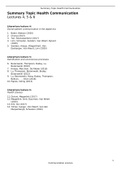Summary Topic Health Communication
Summary Topic Health Communication
Lectures 4, 5 & 6
Literarture lecture 4:
Doctor-patient communication in the digital era
1. Baker, Watson (2020)
2. Chung (2013)
3. Tan, Goonawardene (2017)
4. Linn, Schouten, Sanders, Van Weert, Bylund
(2020)
5. Sanders, Araujo, Vliegenthart, Van
Eenbergen, Van Weert, Linn (2020)
Literarture lecture 5:
Gamification and unconscious processes
6. Baranowski, Thompson, Buday, Lu,
Baranowski (2010)
7. Kroese, Marchiori, De Ridder (2016)
8. Lu, Thompson, Baranowski, Buday,
Baranowski (2012)
9. Lu, Baranowski, Hong, Buday, Thompson,
Beltran, . . . Chen (2016)
10. Papies, Veling (2013)
Literarture lecture 6:
Health Literacy
11. Diviani, Meppelink (2017)
12. Meppelink, Smit, Buurman, Van Weert
(2015)
13. Kim, Xie (2017)
14. Yılmaz, Sungur, Van Weert, Van den
Muijsenbergh, Schouten (2020)
1
Communication science
, Summary Topic Health Communication
Lecture 4 – Patient-provider communication in a digital era
Background
Convergence
Impact internet on communication
Impact internet on patient-provider
Relation
Impact internet on patient-reported
Outcomes
BACKGROUND
Major transition
Sanders et al. (2020):
- Significant changes in today's society, health care policy, and media landscape
- The internet is becoming the first port-of-call for information
Baker et al., 2020:
- Because of the internet, the communication between health care providers (HCPs) and
patients has undergone a major transition
- Traditionally the patient was considered to be a passive recipient of information given by the
doctor.
- Consultations were predominantly healthcare provider-dominated (little to no input from the
patient and they were not part of the discission making process, not part of the agenda-
setting within the conversation).
Spectrum:
Healtcare practitioner dominated consultation < > Patient centred care
On the other side of the spectrum, we have patient centred care in which the doctor
responds to the patient in such a way that it allows …
Patient is able to express all of his/her reasons for visiting the doctor, including
symptoms past feelings and expectations. The doctor takes this into account
during the consultation.
Internet brought - Baker et al., 2020
direct and easy access to abundant health information, thereby increasing patients' autonomy
(more in charge of their own health = power).
Reactions to the growing popularity of online health information - Baker et al.,
2020
"the amount of information could be valuable"
"only for patients, not for me"
"information is irrelevant"
"my patient does not trust me"
CONVERGENCE
The convergence of combining different sources is something that is happening and part of
the paradigm within health communication.
2
Communication science
, Summary Topic Health Communication
What is convergence? - Sanders et al. (2020):
A process in which either one mass communication source and one interpersonal
communication source (intermedium convergence: citing a doctor on a blog) or two mass
communication sources (intramedium convergence: citing another patient on a blog) are
being used to fulfil the user’s needs.
Optimal Matching Model Explains why convergence occurs
If there is a stressor (you are worried) and you want to cope with that stress then you tend to
seek different communication channels in order to reduce your worries and get a better
health.
A match or fit between the demand of a stressor and the function of a coping strategy
results in positive outcomes (stress reduction and better health)
To fulfil your needs, these needs should be matched with the right type of support
Patients actively choose the communication channel that they believe has the highest
potential to fulfil their needs and provide the support required.
Sanders et al. (2020):
Many patients leave the consultation room unsatisfied:
1. Unexplored concerns from patient by provider
2. Lack of trust in a medical expert
3. Information overload by provider
4. Time constraints
5. A lack of experience
6. Difficult to get to see your doctor
7. Time spend in waiting rooms
8. Generic information, not specific enough for the patient (they start to Google their
diagnosis)
As consequence patients rely on other sources (Google) for needs fulfilment
What people do in terms of convergence when using a forum - Sanders et al. (2020)
30.80% contained signs of convergence. These were divided into mass communication
(61.6%) (i.e., other members’ profiles or blogs, news media, and websites) and
interpersonal communication (38.4%) (i.e., medical experts, and family members)
Patients combine sources to ask for information (related to other experiences), enhancing
the sense of belonging, sharing one’s experiences, and asking for factual information.
3
Communication science





